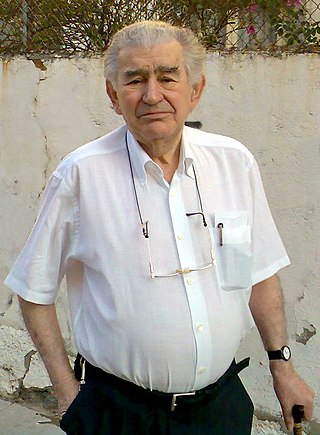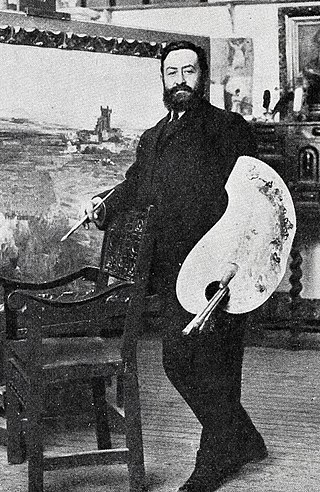
Pelagius was a Hispano-Visigoth nobleman who founded the Kingdom of Asturias in 718. Pelagius is credited with initiating the Reconquista, the Christian reconquest of the Iberian Peninsula from the Moors, and establishing the Asturian monarchy, making him the forefather of all the future Iberian monarchies, including the Kings of Castile, the Kings of León, and the Kings of Portugal.

The Kingdom of Asturias was a kingdom in the Iberian Peninsula founded by the Visigothic nobleman Pelagius. It was the first Christian political entity established after the Umayyad conquest of Visigothic Hispania in 718. That year, Pelagius defeated an Umayyad army at the Battle of Covadonga, in what is usually regarded as the beginning of the Reconquista.

Cantabria is an autonomous community and province in northern Spain with Santander as its capital city. It is called a comunidad histórica, a historic community, in its current Statute of Autonomy. It is bordered on the east by the Basque autonomous community, on the south by Castile and León, on the west by the Principality of Asturias, and on the north by the Cantabrian Sea.

Alfonso IV, called the Monk, was King of León from 925 and King of Galicia from 929, until he abdicated in 931.

Amaya o los vascos en el siglo VIII is a Romantic historical novel published in 1877 and in 1879 by Francisco Navarro-Villoslada, a noted novel by a Navarrese author. The story is placed during the invasion of Visigothic Spain by the Moors.

The Cantabri or Ancient Cantabrians, were a pre-Roman people and large tribal federation that lived in the northern coastal region of ancient Iberia in the second half of the first millennium BC. These peoples and their territories were incorporated into the Roman Province of Hispania Tarraconensis in 19 BC, following the Cantabrian Wars.

The Autrigones were a pre-Roman tribe that settled in the north of the Iberian Peninsula, in what today is the western Basque Country and northern Burgos and the East of Cantabria, Spain. Their territory limited with the Cantabri territory at west, the Caristii at east, the Berones at the southeast and the Turmodigi at the south. It is discussed whether the Autrigones were Celts, theory supported by the existence of toponyms of Celtic origin, such as Uxama Barca and other with -briga endings and that eventually underwent a Basquisation along with other neighboring tribes such as the Caristii and Varduli.
Peter was the Duke of Cantabria. While various writers have attempted to name his parentage,, early sources say nothing more specific than the chronicle of 'Pseudo-Alfonso': that he was "ex semine Leuvigildi et Reccaredi progenitus", and even this has been challenged as a possible politically-motivated fiction created to support his descendants' later claim to exclusive kingship. He was the father of King Alfonso I and of Fruela of Cantabria, father of Kings Aurelius and Bermudo I.
Ruderick, better known by his Spanish name Rodrigo, was an influential noble of the Kingdom of Asturias, and was probably the first Count of Castile (850/862–873) and Álava (867/868–870). He was an active participant in the Reconquista and a faithful vassal of Ordoño I and Alfonso the Great, kings of Asturias. By conquering land from the Moors, Rodrigo began the southern expansion of the County of Castile.

The designation artede (la) repoblación was first proposed by José Camón Aznar in 1949 to replace the term Mozarabic as applied to certain works of architecture from the Christian kingdoms of northern Spain between the end of the 9th and beginning of the 11th centuries. Camón argued that these buildings were related stylistically to the architecture of Asturias and owed little to Andalusian styles. Moreover, since they were built by Christians living under Christian rule, neither were they Mozarabic.

Antonio Gamoneda Lobón is a Spanish poet, winner of the Cervantes Prize in 2006.
Alarcia is a town of northern Spain, Autonomous Community of Castile and León, province of Burgos, Shire of Montes de Oca, sub-shire of Tirón-Rioja Burgalesa, in the municipality of Rábanos. It lies between the reservoir Úzquiza (west) and the peak of San Millan in the Sierra de la Demanda (southeast).

The Theatre of Clunia Sulpicia is a Roman theatre in the ancient city of Colonia Clunia Sulpicia, in what is now province of Burgos, northern Spain. Built on a hill called Alto de Castro, it is located between the modern-day villages of Coruña del Conde and Peñalba de Castro, in the south of the province of Burgos.

John of Castile, called the "el de Tarifa" was an infante of Castile and León. He was engaged in a decades-long fight for control over the Lordship of Biscay with Diego López V de Haro, the uncle of his wife.

Philip of Castile was an Infante of Castile and son of Ferdinand III, King of Castile and León, and his first queen, Beatrice of Swabia. He was Lord of Valdecorneja, and, according to some sources, Knight of the Order of the Temple, in one of those churches, the Church of Santa María la Blanca in Villalcázar de Sirga, he was buried in a coffin adorned with emblems of the Templars.
Leonor Rodríguez de Castro was an infanta of the Kingdom of Castile as the third wife of Philip of Castile.
Oca is a former bishopric in the province of Burgos, Castile and León region, the predecessor of the Roman Catholic Archdiocese of Burgos, and presently a Latin titular see of the Catholic Church. Its Latin adjective is Aucen(sis).
Amaya is a female given name and surname of Spanish, Japanese, and Arabic origins, derived from the village of Amaya and its neighboring mountain in Castile and León, Spain. The name of the village, in turn, has Indo-European roots and means "am (ma)" or "mother". The suffix io-ia is also used to form action names or toponyms, implying that the meaning of Amaya or Amaia is "mother city", as it will be called later, "the capital". Other hypothesis is that the name derived from the Proto-Basque or Basque word Amaia, meaning "the end". Variations include Amaia, Amayah, Ammaya, and Amya.

Marceliano Santa María was a Spanish painter, noted for his Castilian landscapes, historical art, and portraits.

The Interprovincial Council of Santander, Palencia and Burgos was a governing body established on 8 February 1937 to coordinate the Republican areas in Cantabria, Palencia and Burgos during the Spanish Civil War. The council was dissolved in August 1937 after the occupation of the region by Nationalist forces.














